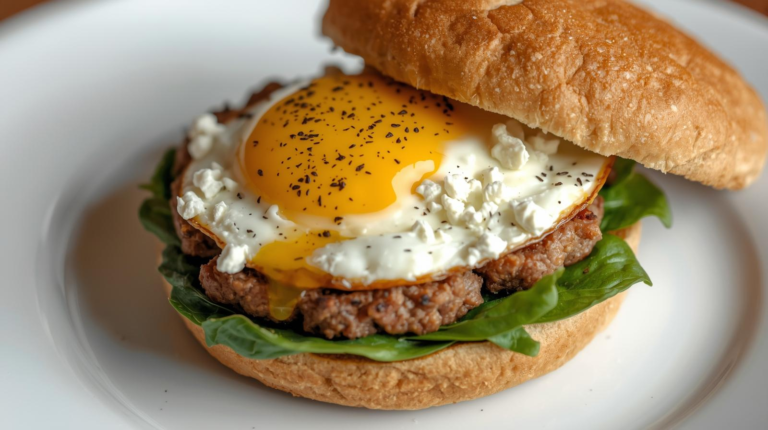There is nothing more satisfying than the sound of a crackling crust as you pull a perfect, golden loaf of artisan sourdough bread from your oven. This recipe is your key to unlocking that incredible experience, even if you’re new to sourdough! Using your active sourdough starter and a simple no-knead method, this recipe lets natural fermentation do all the work, developing a deep, complex flavor and that classic tangy crumb. The secret is baking in a preheated Dutch oven, which creates a steamy environment for a beautiful rise and that signature crisp, rustic crust.
Prep Time: 20 mins
Total Time: 24-36 hrs (includes feeding starter, fermentation, and baking time)
Servings: 1 Loaf (about 12 slices)
Ingredients:
For the Sourdough Bread:
- 4 cups (500g) Bread flour, plus more for dusting
- 1 1/2 cups (350g) Lukewarm water, not hot
- 1/2 cup (100g) Active sourdough starter, bubbly and recently fed
- 2 tsp (10g) Kosher salt
Instructions:
- Mix the Dough: In a large bowl, mix together the bread flour and salt. In a separate medium bowl, stir your active sourdough starter into the lukewarm water until it is mostly dissolved. Pour the starter-water mixture into the flour and mix with a spatula until a shaggy, sticky dough forms and no dry flour remains.
- Bulk Fermentation (First Rise): Cover the bowl with a clean kitchen towel or plastic wrap and let it rest in a warm spot for 4-8 hours. During this time, you’ll perform 3-4 sets of “stretch and folds” every 30-45 minutes for the first 2 hours. To do this, wet your hands, grab a portion of the dough, stretch it upwards, and fold it over the center. Rotate the bowl and repeat 3 more times. The dough is ready when it has risen by about 50% and is jiggly and bubbly.
- Shape the Loaf: Lightly flour a work surface and gently scrape the dough out of the bowl. Gently pull the edges of the dough into the center to form a round ball (a boule). Flip it over, seam-side down, and use your cupped hands to gently drag the dough towards you, creating tension on the surface.
- Second Rise (Cold Proof): Place the shaped dough, seam-side up, into a well-floured banneton or a bowl lined with a floured kitchen towel. Cover it and place it in the refrigerator for a long, cold proof of 12 to 24 hours. This step develops the classic sourdough flavor.
- Preheat Oven and Dutch Oven: When you’re ready to bake, place a 4-6 quart Dutch oven with its lid on in the center of your oven. Preheat the oven to 450°F (232°C). It is crucial that the Dutch oven preheats for at least 30-45 minutes.
- Score and Bake Covered: Carefully remove the hot Dutch oven from the oven. Gently invert your cold dough onto a small piece of parchment paper and score the top with a sharp knife or bread lame. A simple “X” or a single long slash works great. Using the parchment paper as handles, lower the dough into the hot pot. Cover with the lid and bake for 25 minutes.
- Bake Uncovered: After 25 minutes, carefully remove the lid. The bread will be pale but will have “sprung” up. Continue to bake, uncovered, for another 15-20 minutes, or until the crust is a deep golden brown.
- Cool Completely: Carefully remove the bread from the Dutch oven and place it on a wire rack. You must let the bread cool completely, for at least 2-4 hours, before slicing. This is the hardest, but most important step, as it allows the internal crumb to set.
Recipe Notes:
- Active Starter is a Must: Your sourdough starter should be fed 4-8 hours before you plan to mix your dough. It’s ready when it’s bubbly, active, and has at least doubled in size. A “float test” can help: drop a small spoonful into a glass of water, and if it floats, it’s ready.
- The Cold Proof is Magic: Don’t skip the long, cold proof in the refrigerator. This is what develops the signature tangy flavor of sourdough and makes the sticky dough much easier to handle and score.
- Be Extremely Careful: The preheated Dutch oven will be incredibly hot. Always use heavy-duty oven mitts and be mindful when handling it.
- Scoring Your Dough: Scoring isn’t just for looks; it gives the bread a designated place to expand, preventing it from bursting open in other places. A confident, quick slash about 1/4 to 1/2 inch deep works best.
- Flour Choice: Bread flour has a higher protein content than all-purpose flour, which helps create a stronger gluten network for a chewier crumb and better rise. You can use all-purpose flour, but the result may be slightly denser.
There you have it—a stunning, bakery-quality loaf of rustic sourdough bread made in your own kitchen! The pride you’ll feel when you slice into this warm, tangy, and crusty loaf is just as wonderful as its incredible taste. We hope this becomes a staple in your home. Happy baking!
Estimated Nutritional Information (per slice)
Calories: 140; Fat: 0g; Carbohydrates: 28g; Sugar: 0g; Protein: 5g; Sodium: 380mg; Fiber: 1g;
Disclaimer: Nutritional information is estimated and can vary depending on specific ingredients, brands, and serving sizes used. This information is provided for guidance only and should not be considered a substitute for professional medical or nutritional advice.






